Franchise Rewind: The Lord of the Rings: The Fellowship of the Ring (2001) The Two Towers (2002) The Return of the King (2003)
The Lord of the Rings: The Fellowship of the Ring, 2001 (Elijah Wood) New Line Cinema
The Lord of the Rings: The Two Towers, 2002 (Ian McKellen) New Line Cinema
The Lord of the Rings: The Return of the King, 2003 (Viggo Mortensen) New Line Cinema
“You cannot pass! I am a servant of the Secret Fire, wielder of the Flame of Anor. The dark fire will not avail you, Flame of Udun! Go back to the shadow. You shall not pass!”
Kim’s Underground was an incredible place. It was a video store in Greenwich Village where I had a coveted membership. Coveted because Kim’s had the most expansive, diverse collection of rare, independent, and (as in the title) underground videos in the world, and they were very picky about memberships—kind of like a fellowship, if you will. Kim’s was where I found Shock Treatment and Sam Raimi’s Crimewave at a time when both videos were out of print. I also found a little-known or seen 1989 movie called Meet the Feebles, directed by Peter Jackson.
It was his second feature film (after 1987’s Bad Taste). It’s basically The Muppet Show with graphic sex and violence, but it’s brilliant, fresh, horrifying, and funny. I had already seen Bad Taste and Braindead (what a weird movie!) as well as Heavenly Creatures, so I was familiar with Jackson’s work. We didn’t know what to expect. He was a Tim Burton unafraid of an X-rating, or a pre-Spiderman Sam Raimi, but not quite.
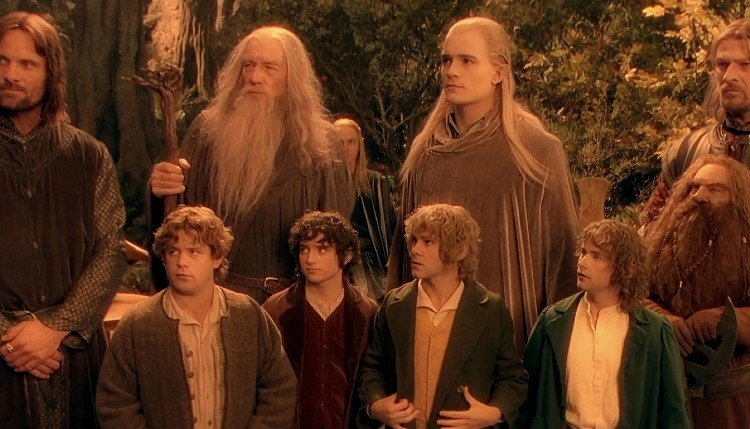
The closest comparison I could make would be Guillermo del Toro, and that seems to fit because both filmmakers disappoint me these days with expensive, over-hyped work that doesn’t match the tenacity, ambition, and fearlessness of their younger, hungrier days. Jackson may have still been hungry when he embarked on a journey worthy of Tolkien. Think of Jackson as a plump hobbit-filmmaker and the quest as one of completing shooting of three epic films in just over a year.
I have some theories as to how this was achieved. Jackson sequestered his cast and crew in New Zealand for the duration of shooting and reshoots. New Zealand is an inexpensive location in which to shoot. Finally, Jackson’s work ethic would put most contemporary filmmakers to shame. He took an extraordinary hands-on approach to shooting, production design, and visual effects while most filmmakers these days merely direct performance and call “action” and “cut.”
The story goes that Jackson (with his wife and collaborator Fran Walsh) set out to create an elaborate, sprawling fantasy epic, but it seemed every story idea borrowed liberally from J.R.R. Tolkien. Enter Harvey and Bob Weinstein who secured the rights to Tolkien’s books for Jackson and made side deals with New Line Cinema and Saul Zaentz as Miramax didn’t have the $90 million per-movie budget outlay. New Line accepted the budget and the trilogy proposal and Jackson started production. If there was ever a perfect tourist brochure for New Zealand, it is this movie.
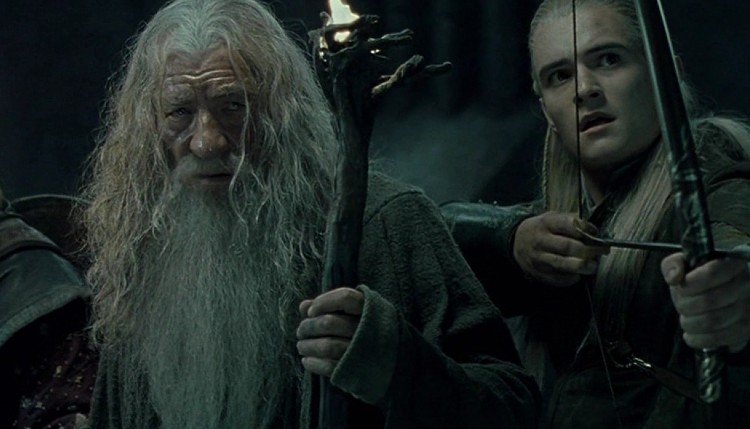
The Fellowship of the Ring is one of the most beautifully shot, composed, and designed films in a very short history of filmmaking. Look at how far we’ve come from Thomas Edison’s murky experiments starting in 1891. This movie (and trilogy) represented the end of conventional filmmaking. You can tell from the use of color and the dimension in the spherical lenses of cameras that were still striking film to get images. This may also be the last film ever made to look like an old-fashioned movie. After that, color seemed to disappear from films. Everything became murky (and flat) once again.
The Fellowship of the Ring is the strongest movie of the trilogy because of the introduction of the premise and the gathering of the characters. An elderly Bilbo Baggins (Ian Holm) welcomes Gandalf the Grey (Ian McKellen) to the Shire: the village of the Hobbits. Bilbo found the “one ring,” created by Sauron to conquer all other rings created for elves and dwarves and such. I wonder if the ring represents the doomsday power of the hydrogen bomb, which could yield far more destructive power than the atom bomb—one bomb to rule all bombs.
The books were written at the height of the “atomic age” as well as the Cold War. It’s basically like we have this powerful weapon, but a greater power devises a more powerful weapon to control the other weapons. Gandalf recognizes the ring for the evil it invokes and advises Bilbo to dispense with it. Better yet, have Bilbo’s nephew, Frodo (Elijah Wood) go out to Mount Doom (where the ring was forged) and toss it into the hot, nasty lava, destroying it.
Gandalf, with half-elven Elrond (Hugo Weaving), assembles the Fellowship to be made up of himself, tracker Aragorn (Viggo Mortensen), elf Legolas (Orlando Bloom), dwarf Gimli (John Rhys-Davies), Boromir (Sean Bean), Frodo and his friends, Samwise (Sean Astin), Merry (Dominic Monaghan), and Pippin (Billy Boyd). Things go to hell in a hurry when Boromir, suddenly overcome with lust for possession of the ring, attempts to kill Frodo in a prelude to an Orc ambush, which separates everyone.
Once we get the band together, the whole thing falls apart in short order, and Frodo and Sam are left on their own to get to Mount Doom, and it takes two long movies to get there. Aragorn and the others set out to search for Merry and Pippin and run afoul of goblins in a cave, and Gandalf must do battle with the Balrog to create a diversion so the rest of the gang can escape. Jackson (and New Line Cinema) gambles on whether or not this will be enough to have audiences return for the second movie. As it happened, it was.
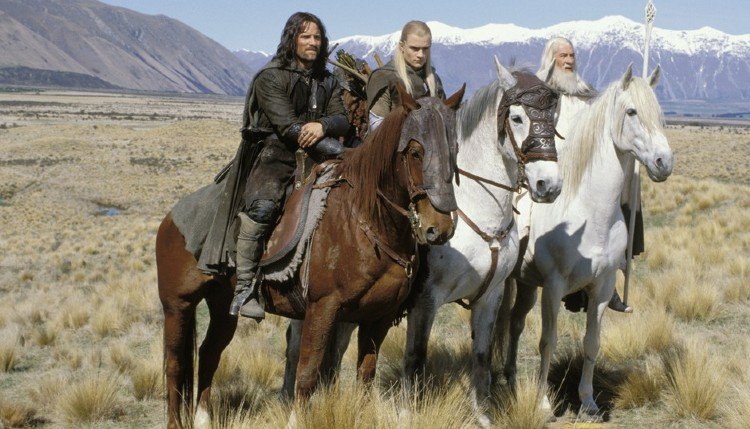
Thee Rings for the Elven-kings under the sky,
Seven for the Dwarf-lords in their halls of stone,
Nine for Mortal Men doomed to die,
One for the Dark Lord on his dark throne
In the Land of Mordor where the Shadows lie.
One Ring to rule them all, One Ring to find them,
One Ring to bring them all and in the darkness bind them
In the Land of Mordor where the Shadows lie.
So we started off with a “fellowship,” a group or organization with a mission statement. We assembled the team. We started the band. The band broke up. The fellowship dissolved in roughly an hour of screen time. Frodo, being kind of a pain in the ass, decided to set off alone, but his friend and employee (it’s a complicated relationship), the gardener Samwise (Sean Astin) kept with him while the human, elf, dwarf, and wizard went in the opposite direction, searching for Frodo and Sam’s friends, Merry and Pippin.
We only get a glimpse of Gollum in the first movie, but here he makes his appearance as the sickening creature who once held the ring in his hands. Tolkien’s mythos suggests karma-like retribution for Gollum’s evil by making him skeletal and gangly; turning him into a monster, the evil Yoda determined to destroy Frodo and Sam. Frodo, being an idiot, is trusting of Gollum, but Sam knows wiser. In fact, Sam’s the real hero of the trilogy, like R2-D2; unsung but loved. He had the hardest job of anybody in the fellowship: he had to keep Frodo sane.
The length of the movies begins to become noticeable with The Two Towers, even as this second movie is considered the best of the three. Scenes seem stretched out, much in the way Denis Villeneuve’s Dune pads key scenes (one of the bigger problems with recent cinematic adaptations) which add to the running time. Because the characters have been separated, we have three storylines all trailing off into different places, and some adventures are more interesting than others.
We get an hour of Frodo and Sam (with Gollum) traipsing through different barren territories. We get an hour and a half of Aragorn and his buddies preparing for the battle at Helm’s Deep. Finally, we get about a half an hour of Merry and Pippin beset by Orc and ultimately captured by Garamir, Boromir’s brother, from Ithilien. Jeez, Tolkien couldn’t follow this plot! I kid. The subtitle of the movie could be The Scattering of the Fellowship.
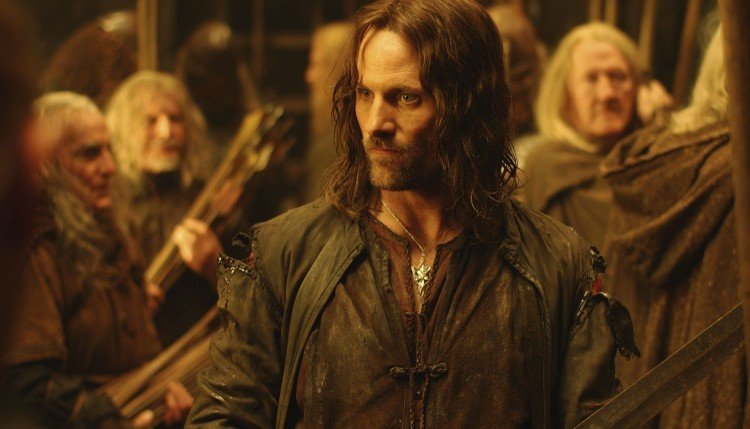
This movie, like The Empire Strikes Back, has it all (except possibly the icky-sticky romance of the first movie): drama, battle, fantasy, skeletons in water, big trees and elephants. The ending is awkward, owing to the connective tissue of The Return of the King. Tolkien makes a statement with the first movie; his beginning is strong, but then he wavers in the middle and falls almost completely flat with his conclusion. Jackson suffers the same result in slavishly adapting the story for film.
Yet, there is so much to recommend for The Two Towers. It’s a gorgeous movie, not always dependent on the staggering visual effects work. The cast is perfect, even if many characters are either redundant or purposeless. Though, to cite Joseph Campbell, I don’t know if this is so much a “hero’s journey” as it is a “hero’s forced walk.”
“My friends. You bow to no one.”
The Return of the King begins with Gollum’s origin story. He was once a peaceful, happy hobbit who sees the ring in the shallows of a pond and, almost instantly, becomes a madman. He strangles his cousin, Déagol, and takes the ring. Pariah to the Shire, he pounds the wastes between worlds in Middle Earth. It’s never explicitly stated what powers, barring invisibility, the ring might have, but those captive to the ring salivate over its beauty (or perhaps purity).
I’ve always wondered why invisibility would be considered the ultimate power, and something every creature would crave. Some of us, including me, want to disappear, but that’s in the more metaphorical sense, and not literal transparency. It then occurred to me that those who seek the power of invisibility may already be innately evil or selfish. In this pre-credit scene, we finally understand Gollum—why he is what he is—and how it sheds light on what the ring is capable of doing to its wearer.
That’s all we really get (in a revelatory sense) in the three hours of film that is the final chapter in the trilogy of Lord of the Rings. Each of the three storylines continues until two of them converge while the third plays out on the top of Mount Doom in Mordor. The ring is indestructible only to a certain point. You can’t shatter it (as Aragorn attempted, destroying his sword) and you can’t bend it. The ring, being forged in the hot, nasty lava of a volcano, can be destroyed only there.
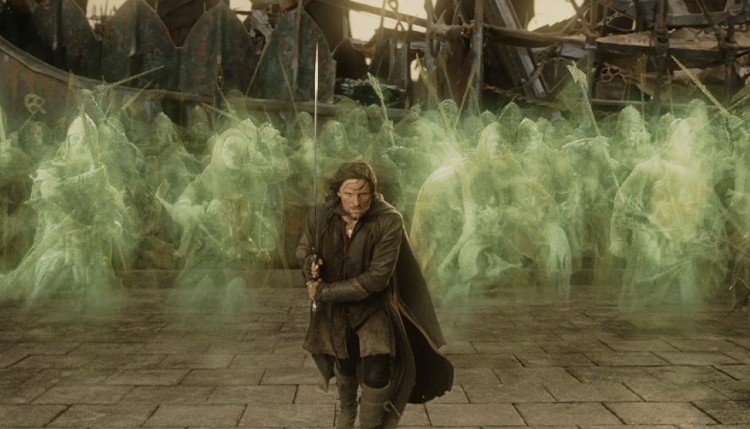
Why would anybody make these rings**? What purpose do they serve except as weapons? Aragorn and his friends, fresh from the battle of Helm’s Deep, prepare for the final battle with Sauron’s Orcs, and all manner of ogre, troll, and big elephant. It’s never explicitly stated why there must be war. If it’s for the ring, then these guys are in the wrong place. Frodo, Sam, and Gollum make it past Mordor’s defenses, courtesy of a back door, and start the treacherous journey up the mountain where they are met by Shelob, a really big spider who drains the life from Frodo and wraps him in her silk.
Sam rescues Frodo, but the damage has been done. Some of the editing in these final sequences bothers me. It reminds me of Return of the Jedi when Luke defeats Vader and the Emperor just as Han Solo and company manage to bring down the shield of the Death Star so that Lando and his gang can get in there and blow it up. You see what I’m saying? It’s a little too convenient. Just as the tide turns for Aragorn, Gimli, and Legolas, Frodo and Sam make it to the top of the mountain.
Frodo can’t bring himself to toss the ring into the fire. Luckily, Gollum is there to commit his final act of stupidity in a long history of acts of stupidity. He finally gets his “precious,” but … let’s just say he got a little hot under the collar! He … went for a little swim? Just when you think the credits are ready to roll, we still have another half hour to go! My reviews of the three films are based on the theatrical versions, and not the “extended versions,” which add an extra hour to the running time of each movie.
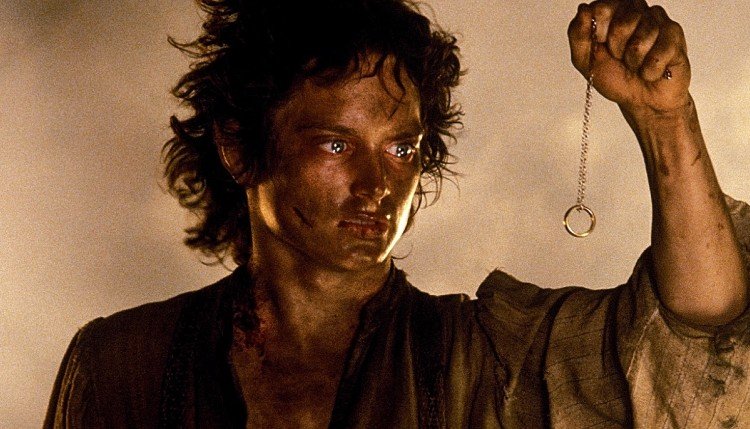
I might have structured things a little differently, instead of going for strict chronology. I stated earlier that we could start to feel the length of the movies in The Two Towers, but in the final thirty minutes of The Return of the King, there were audible complaints in the audience. It’s like Jackson didn’t want to stop telling his story. He went overboard and he would continue to go overboard with his three hour version of King Kong. Aragorn is crowned as King of Gondor. (He’s the “king,” get it?) Frodo, Sam, Merry, and Pippin go back to the Shire.
Frodo lives for four more years before being consigned to the Undying Lands, which is a fancy-pants way of saying he died as a result of Shelob’s poison. It’s staggering the box office success of these three movies, and equally impressive that audiences continued to flock to theaters, earning the trilogy close to $3 billion in box office receipts. The films (as well as the extended versions) earned even more money in home video iterations. Jackson did move away from Tolkien for a time to make King Kong and The Lovely Bones, but he returned in 2012 to make his Hobbit trilogy. More on that later.
*This was back when you had to actively search for titles. Rising rent killed the video rental business in New York City and sent shops like Kim’s into bankruptcy.
**We get something of an origin story for the rings in Rings of Power.

